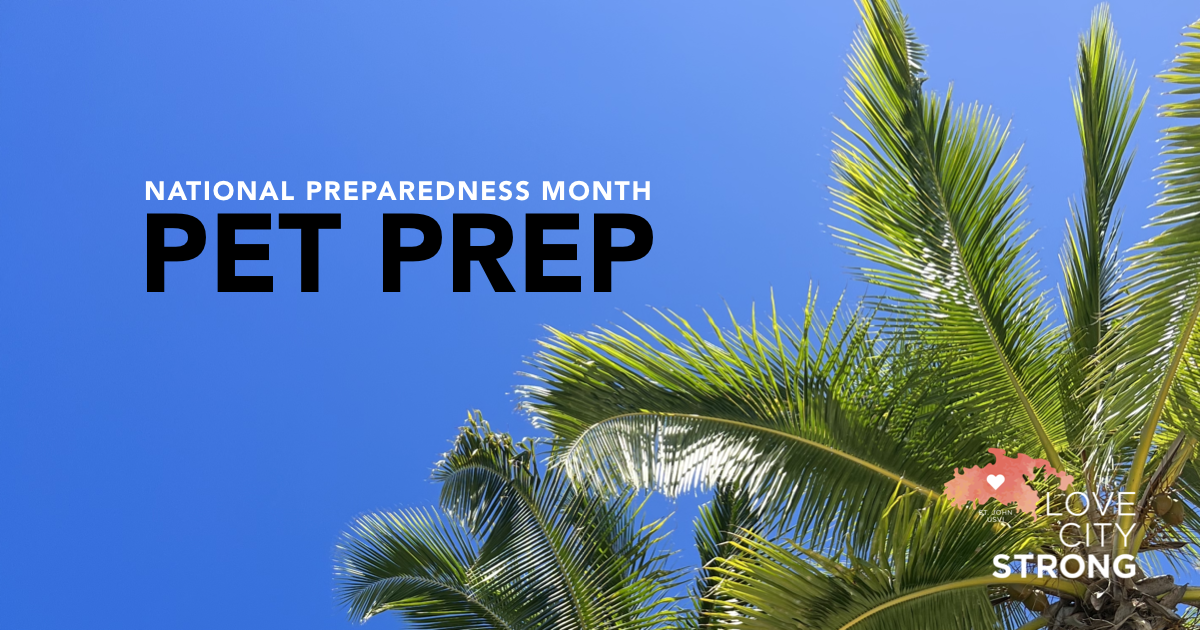
Plan For Your Pet

National Preparedness Month is in its final week! This year’s theme is “A Lasting Legacy: The life you’ve built is worth protecting.” All month long we are sharing tips and best practices related to individual, household, and community preparedness. Preparing for disasters is important for you and your family – including your pets!
This week’s topic is: Pet Preparedness
Our pets are family, no doubt about it. It makes sense, therefore, that when we make a plan for the rest of the household, we also plan for our pets. Sheltering, food and water, entertainment, safety… all of these are important considerations for our human AND animal family.
Make a Plan for your Pet
By planning in advance, you can help minimize stress on yourself and your pet. Due to rapidly changing circumstances, you may need to make decisions quickly in an emergency. For example, if you need to go to a shelter, make sure they can accommodate your pet. If they can’t, you’ll need alternate, safe arrangements for them. Most importantly, do not leave your pet behind – they could end up lost, injured, or worse.
- Have an evacuation plan for your pet. In addition to knowing shelter policies, make sure you have the necessary documentation to ensure that your pet can travel with you if needed.
- Plan with neighbors, friends, or family to make sure that someone can take care of your pet if you are unable to do so.
- Get your pet microchipped! Keep your address and phone number up to date and include emergency contact information.
Build a Kit for your Pet
During Pet Preparedness Month in June, our Friends at the Humane Society of St Thomas outlined the top 10 items you should include in your pet preparedness kit:
- Food: At least a three-day supply in an airtight, waterproof container.
- Water: At least three days of water specifically for your pets.
- Medicines and medical records: Most boarding kennels, veterinarians and animal shelters will need your pet’s medical records to make sure all vaccinations are current in case of emergency.
- Important documents, for example, registration information, adoption papers and vaccination documents. Talk to your veterinarian about microchipping and enrolling your pet in a recovery database.
- First aid kit, including cotton bandage rolls, bandage tape and scissors, antibiotic ointment, flea and tick prevention, latex gloves, isopropyl alcohol and saline solution. In addition, including a pet first aid reference book is a good idea.
- Collar or harness with ID tag, rabies tag and a leash.
- Crate or pet carrier: Have a sturdy, safe crate or carrier in case you need to evacuate. The carrier should be large enough for your pet to stand, turn around and lie down.
- Sanitation: Pet litter and litter box if appropriate, newspapers, paper towels, plastic trash bags and household chlorine bleach.
- A picture of you and your pet together: If you become separated, a picture of you and your pet together will help you document ownership and allow others to assist you. Add species, breed, age, sex, color and distinguishing characteristics.
- Familiar items such as treats, toys and bedding can help reduce stress for your pet.
Stay Informed
Be prepared and stay informed about current conditions. Pay attention to alerts sent by local government and emergency management agencies and listen to evacuation orders. Above all, always bring pets inside at the first sign of a storm or disaster.
There’s no better time to start preparing than today! For more information on how to create a written emergency plan, including downloadable plan templates, videos, and activities to get children involved in the preparation process, visit www.ready.gov/pets. For up to date, reliable forecasts, visit the National Hurricane Center website. In the Virgin Islands, specific alerts, watches, and warnings are available on VITEMA’s website, or you can sign up for AlertVI.
